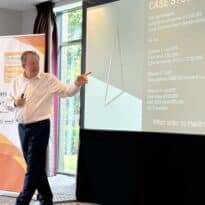Stephen Tong is a portfolio manager for the Mid Wynd International Investment Trust.
Around 20 years ago, in an infamous mishap at the Glenmorangie Company’s bottling facility, one of the world’s most heavily peated single malts was inadvertently vatted with an altogether less distinctive brand of Scotch. Managers initially resolved to dispose of the resulting concoction, but then they found it actually tasted rather nice.
This discovery led to a dramatic change of plans, and strictly limited supplies were duly put on the market. Sold under the appropriate name of Serendipity, the accidental blend proved quite a success.
Do such agreeable quirks of fate occur in the investment world? Perhaps. Take the challenge of combining a desire for financial performance with a respect for environmental, social and governance (ESG) considerations.
Sustainable “compounders”
Our key investment principles centre on identifying “compounders” – companies we consider to be high-quality businesses that can generate substantial returns on capital, reinvest at similar returns and compound cash flows over time. We would call this ‘financial productivity’.
Many investors undervalue companies with high financial productivity. This is largely because economic theory suggests the profits these businesses enjoy will attract competition that could ultimately reduce the original company’s returns on capital. This could be through taking away market share or forcing down prices, for example.
In reality, this theory is regularly debunked. Companies can have enduring competitive advantages that enable them to maintain market leadership for longer than widely expected. They often generate share-price outperformance as a consequence. In other words, financial productivity can be positively correlated with shareholder returns.
In distilling compounders from the global universe of companies, it is critical to assess ESG opportunities and risks through fundamental research, to understand the level of financial productivity going forward. This key step in the analytic process is known as ESG integration.
Some relationships every investor should know about
What is interesting, in our experience, is that if you focus on companies with outstanding financial productivity you often find yourself in a sweet spot for ESG almost by default.
The reason is simple. The most financially productive businesses are frequently asset-light, which typically translates into a low carbon intensity business with a cleaner environmental profile. We tend to avoid asset-heavy, high carbon intensity sectors such as energy, materials and utilities, because these businesses seldom generate the high levels of financial productivity we seek.
Additionally, in our experience, companies generating high financial productivity also tend to have strong corporate governance. They are well managed, particularly in their ability to sustain their competitive moats and having capital discipline when reinvesting back into their business.
So, the underlying ingredients of compounders – high financial productivity and reinvestment – mean compounders tend to have an attractive ESG flavour, in our experience.
Reconciling key investment goals
This has important implications. It means investors who concentrate on compounders can address both their return objectives and their ESG objectives: they can have both without a need to choose one over the other. It’s all about the ingredients and taking the heart of the distillation.
As evidence of this, the Mid Wynd International Investment Trust has the highest five-globes sustainability rating from Morningstar, implying the portfolio has low ESG risks. Furthermore, its carbon footprint is about 95% lower than that of its benchmark, the MSCI All Country World Index, according to Morningstar Sustainalytics (as of 31 July 2024).
In our case this may not qualify as serendipity in the strictest sense. Our strong sustainability scores are no accident – unlike that aforementioned whisky. But it might serve as a useful lesson for anyone seeking outperformance and more far-reaching benefits. And that reminds me…
Unopened examples of the Glenmorangie Company’s fortuitous blend, a mix of Ardbeg and Glen Moray, should you be interested, can now sell for £350. That is almost ten times their original asking price – a return of over 11% a year. Another decent long-term investment, you might say. A toast, then: to successful and sustainable investing!
































